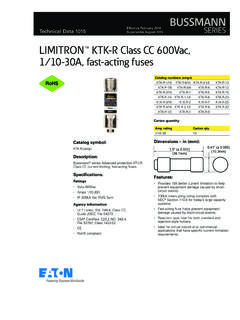Transcription of Membrane lipid composition and cellular function
1 L e I. Membrane lipid composition and cellular function Arthur A. Spector and Mark A. Yorek Departments of Biochemistry and Internal Medicine, University of Iowa, Iowa City, IA 52242. Abstract Membrane fatty acid composition , phospholipid in the bilayer can modulate the activity of Membrane composition , and cholesterol content can be modified in many proteins. different kinds of intact mammalian cells. The modifications are At the time that the fluid mosaic model was formulated, extensive enough to alter Membrane fluidity and affect a number of cellular functions, including carrier-mediated transport, the evidence was becoming available that Membrane lipids properties of certain Membrane -bound enzymes, binding to the can influence the function of certain Membrane proteins. insulin and opiate receptors, phagocytosis, endocytosis, depolar- For example, it already was known that when human ization-dependent exocytosis, immunologic and chemothera- erythrocyte membranes were exposed to phospholipase A*, peutic cytotoxicity, prostaglandin production, and cell growth.
2 Which hydrolyzes fatty acyl groups from the sn-2 position The effects of lipid modification on cellular function are very complex. They often vary from one type of cell to another, and of glycerophospholipids, glucose transport was reduced by Downloaded from by guest, on April 12, 2019. they do not exert a uniform effect on all processes in a single cell 75% (2). In addition the Na' + K'-ATPase activity of the line. Therefore, it is not yet possible to make any generalizations erythrocyte Membrane was decreased. Incubation with or to predict how a given system will respond to a particular type phospholipases C or D, which remove the phospholipid of lipid modification. Many of the functional responses probably head groups located on the surface of the Membrane lipid are caused directly by the Membrane lipid structural changes, which affect either bulk lipid fluidity or specific lipid domains. bilayer, had much less effect on glucose transport and Na'. The conformation or quaternary structures of certain trans- + K+-ATPase activity.
3 While such studies established that porters, receptors, and enzymes probably are sensitive to changes the structure of the lipid bilayer can influence the activity in the structure of their lipid microenvironment, leading to of a Membrane protein, they provided no information as changes in activity. Prostaglandin production is modulated by to whether such effects actually occurred in an intact cell. the availability of substrate fatty acids stored in the Membrane phospholipids, but the underlying chemical mechanism still From the standpoint of cellular physiology and metabolic involves a change in Membrane lipid structure. While this is the regulation, the critical questions were whether changes in most likely mechanism, the possibility that the Membrane lipid Membrane lipid composition actually can occur in a compositional change is an independent event that occurs con- living cell and if so, whether the changes are of sufficient currently but is not causally related to the functional perturba- magnitude to influence Membrane function .
4 An extensive tions also must be , A. A., and M. A. Yorek. Membrane lipid composition and cellular function . J. amount of information regarding these issues has been lipid &s. 1985. 26: 1015-1035. obtained during the last decade, much of it from studies with mammalian cells in culture. Supplementary key words fatty acid phospholipids cholesterol The purpose of this review is to briefly describe the Membrane fluidity Membrane transport enzymes receptors types of changes in Membrane lipid composition that can prostaglandins cell culture be produced under biological conditions and their func- tional consequences, with emphasis on data obtained from cell culture studies. A comprehensive review dealing with lipid effects on Membrane function was prepared I. BACKGROUND recently by Stubbs and Smith (3). Additional reviews are available on related topics, including the effect of lipids on Mammalian cell membranes consist of a lipid bilayer Membrane bound enzymes (4), Membrane asymmetry (5, composed primarily of phospholipids and cholesterol.)
5 S), the dynamics of Membrane structure (7) and lipid Proteins that have important cellular functions, such as metabolism in cultured cells (8). receptors, transporters, and enzymes are embedded in the lipid bilayer. The dynamic state of the lipids in the bilayer was described in 1972 by Singer and Nicolson (1) as one Abbreviations: ESR, electron spin resonance; S, Membrane order of the fundamental tenents of the fluid mosaic model of parameter; T ~ probe , motion parameter; 12-NS, 12-nitroxide stearic acid; , 5-nitroxide stearic acid; DPH, 1,6-diphenyl-1,3,5-hexatriene;. Membrane structure. A basic question raised by this for- 11, Membrane viscosity; PGEI, prostaglandin E,; PG12, prostaglandin mulation was whether interactions with lipids contained I,; TXA,, thromboxane A,. Journal of lipid Research Volume 26, 1985 1015. A. Cultured cells as a model system fatty acids in the cell phospholipids could be varied from A number of early observations indicated that it might 28 to 85% (12).
6 In other experimentsthe linoleic acid be possible to produce Membrane lipid modifications in content was raised from an undetectable amount to 37%. cultured cells. Mammalian cells were foundto readily of the phospholipid fatty acyl groups by supplementing a take up lipidscontained intheculturemedium, with serum-free medium with linoleic acid bound to albumin much of thefatty acid and cholesterol taken up being (13). Phospholipid fatty acyl modifications also were pro- utilized for Membrane synthesis (8). When the culture duced in 3T3 cells by growing them in a culture medium medium contains an adequate supply of lipids , fatty acid containing lipid -depleted serum, supplemented with and cholesterol synthesis are suppressed, and most of the specific fatty acids (14). cellular lipids are derived from the material that is taken Although useful in certain cases, these methodsare up from findings suggested that it limited in thatmany diploid cells cannot be grown in might be possible to influence the lipid composition of adequate amounts in either a serum-free medium or a cells by controlling the type of lipids added to the culture mediumthatcontainslipid-extractedserum.
7 However, medium. As an extension of this work, it was found that subsequent studies with human skin fibroblasts indicated certain cells can be propagated in a serum-free medium. that it is not essential to remove the serum lipids from the There was a concern initially that such cultures might culture medium. Extensive modifications in the fibroblast stop growing when either linoleic acid (18:2)' or related fatty acyl composition were produced by adding specific essential polyunsaturatedfatty acids becamedepleted. fatty acids to the usual growth medium containing 10%. However, this proved not to be the case (9). Certain cells fetal bovine serum. The cultures continued to grow nor- grown under these conditionsdonot have measurable mally under these conditions, and largequantities of amounts of polyunsaturatedfatty acids in Membrane lipid -modified fibroblasts could be produced (15). In addi- Downloaded from by guest, on April 12, 2019. phospholipids; instead, they containlargequantities of tion it was observed that fibroblasts can be modified even two monounsaturates that can be produced biosyntheti- after the cultures becameconfluent (15).
8 Supplementation cally, oleic (18:l) and palmitoleic (16:l) acids (10). By con- of the medium with specific fatty acids is currently the trast, when these cells are grown in the presence of serum most widely used method for producing Membrane lipid they normallycontain 20-30% polyunsaturatedfatty modifications in cultured cells. acids (8). Considering these two cases as extremes, it be- Fairly extensive phospholipid fatty acyl modifications came clear that variants of a cell line having widely differ- also can be produced in certain cells by replacing fetal ing Membrane fattyacid compositions could be produced bovine serum with horse serum in medium (16). These simply by altering the lipid content and composition of differences apparently result from the fact that horse the culture medium. serumcontains65%morePolyunsaturatedfatty acid than fetal bovine serum (16). 11. METHODS FOR MODIFYING. lipid composition B. Phospholipids Cultured cells can take up large quantities of intact Most Membrane lipid modifications in cultured cells phospholipids from unilamellar vesicles without affecting are produced by supplementing the medium with specific cell viability (17).
9 About 20-30% of the uptake remains lipids , usually associated with theplasmamembrane. At37OC, the also is possible to modify the phospholipid composition predominant process that occurs is fusion of the vesicle and cholesterol content of cells by incubation with differ- with the cell Membrane (18). If the incubation is carried ent types of liposomes. out at 2"C, however, phospholipid uptake occurs through A. Fatty acid and serum supplements an exchange between the outer leaflet of the vesicle and the cell Membrane (19). Under these conditions the phos- The first studies with lipid supplements were done with pholipids that enter the plasma Membrane are associated mouse L M cells, a variant of the L fibroblast that can initially with the outerleaflet of the lipidbilayer. Phospho- grow in a serum-free medium. By adding dl-desthiobiotin lipids that have been incorporated into cell membranes by to inhibit fatty acid synthesis together with various fatty incubation with liposomes include phosphatidylethanola- acid esters ofTween, large differences in the fatty acid mine (20) variety of phosphatidylcholines including composition of the LM cell phospholipids were produced egg yolk, dioleoyl, dipalmitoyl and dimyristoyl(21).
10 Lipo- (11). Usingthisapproach,thepercentage of saturated somes also can beemployed to insert fluorescent analogues of phosphatidylcholine, phosphatidylethanolamine, and phosphatidic acid into the plasma Membrane of intact 'Fatty acids are abbreviated as number of carbon atomxnumber of double bonds. Thus, 18:2 contains 18 carbon atoms and two double cells (22-24). These compounds contain the fluorescent bonds. N-4-nitrobenzo"i!-oxa-1,3-diazole aminocaproyl group in 1016 Journal of lipid Research Volume 26, 1985. the sn-2 position. They are presented to cells as compo- neurons (27), 3T3 cells (28), and neuroblastoma cells nents of small, unilamellar dioleoyl phosphatidylcholine (29). Increasing amounts of the ganglioside are taken up vesicles. Based upon the distribution of these analogues as as the extracellular concentration is raised. These ap- visualized by fluorescence microscopy, it appears that proaches can be employed to examine the effects of sphingo- phospholipids taken up from liposomes are incorporated lipid content and composition on cellular and Membrane into the nuclear Membrane , mitochondria, and Golgi ap- function .



